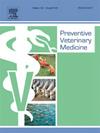Short-term associations between ambient ammonia concentrations and growing-finishing pig performance and health
IF 2.2
2区 农林科学
Q1 VETERINARY SCIENCES
引用次数: 0
Abstract
Using sensors, the health and welfare of growing-finishing pigs can be continuously monitored by detecting deviations from pigs’ normal behaviour, but the validity of such algorithms requires improvement. As changes in the environment influence pig behaviour, monitoring temporal changes in environmental factors may help identify periods with a higher risk of welfare issues. The real-time relationships between pig welfare and many environmental factors are, however, not well-understood. This study examined the short-term associations of ambient ammonia with indicators of pig production and health. Ambient ammonia concentrations were monitored with sensors during the growing-finishing period of three rounds at a German (farm G, n = 110 pigs/round) and one round at a Danish farm (farm D, n = 144 pigs). Body weight was estimated daily using 3D cameras (both farms), feed intake was recorded using electronic feeding stations (only farm G), and health indicators were recorded during twice- (farm G) or thrice-weekly (farm D) farm visits. Using splines (generalised additive models), ammonia concentrations were linked to indicators of pig production and health in real time and, for body weight, at a lag of 1, 2, 3 and 7 d. We found a range of relationships between ambient ammonia (5 – 50 ppm) and production or health indicators (i.e. body weight (real-time and lagged), feed intake, coughing, sneezing, pen fouling, diarrhoea, and tear staining), but they were highly inconsistent between farms and pig rounds. Part of this inconsistency may be due to differences in manure management and sensor locations, or could be explained by age or seasonal effects (e.g. heat stress). More robust relationships were identified for clinical measures related to pig behaviour, where tail damage and skin lesions linearly increased with ammonia from low concentrations (5 – 10 ppm) onwards, hence suggesting more tail biting and aggression at higher ammonia concentrations. In conclusion, ambient ammonia did not clearly associate with pig performance and health in the short term, while higher ammonia concentrations were related to higher occurrences of clinical signs reflecting undesirable behaviours. Therefore, daily ammonia measurements using sensors may be of limited value in identifying health issues in pigs, but they may aid in detecting periods with high risk of aggressive or tail biting behaviours that require interventions. As ambient ammonia was confounded with other environmental measurements, such as ambient temperature or carbon dioxide concentrations, identified associations should be interpreted cautiously or with ammonia as general indicator of air quality.
环境氨浓度与生长肥育猪生产性能和健康之间的短期关系
利用传感器,可以通过检测猪的正常行为偏差来持续监测生长肥育猪的健康和福利,但这种算法的有效性需要改进。由于环境变化会影响猪的行为,监测环境因素的时间变化可能有助于确定福利问题风险较高的时期。然而,猪福利与许多环境因素之间的实时关系尚未得到很好的理解。本研究考察了环境氨与生猪生产和健康指标的短期关系。在生长-肥育期间,用传感器监测德国农场(G农场,n = 110头猪/轮)和丹麦农场(D农场,n = 144头猪)的三轮环境氨浓度。每天使用3D摄像机估计体重(两个农场),使用电子饲养站记录采食量(仅农场G),并在两次(农场G)或三次(农场D)农场访问期间记录健康指标。使用样条(广义加性模型),氨浓度实时与猪的生产和健康指标相关联,对于体重,滞后1、2、3和7天。我们发现了环境氨(5 - 50 ppm)与生产或健康指标(即体重(实时和滞后)、采食量、咳嗽、打喷嚏、猪圈污染、腹泻和眼泪染色)之间的一系列关系,但它们在农场和猪轮之间高度不一致。这种不一致的部分原因可能是粪便管理和传感器位置的差异,或者可以用年龄或季节影响(例如热应激)来解释。在与猪行为相关的临床测量中发现了更牢固的关系,从低浓度(5 - 10 ppm)开始,尾巴损伤和皮肤损伤呈线性增加,因此表明在较高的氨浓度下会有更多的咬尾和攻击行为。综上所述,环境氨在短期内与猪的生产性能和健康没有明显的联系,而较高的氨浓度与反映不良行为的临床症状的发生率较高相关。因此,使用传感器的每日氨测量在识别猪的健康问题方面可能价值有限,但它们可能有助于发现需要干预的攻击性或咬尾行为的高风险时期。由于环境氨与其他环境测量(如环境温度或二氧化碳浓度)相混淆,应谨慎解释已确定的关联,或将氨作为空气质量的一般指标。
本文章由计算机程序翻译,如有差异,请以英文原文为准。
求助全文
约1分钟内获得全文
求助全文
来源期刊

Preventive veterinary medicine
农林科学-兽医学
CiteScore
5.60
自引率
7.70%
发文量
184
审稿时长
3 months
期刊介绍:
Preventive Veterinary Medicine is one of the leading international resources for scientific reports on animal health programs and preventive veterinary medicine. The journal follows the guidelines for standardizing and strengthening the reporting of biomedical research which are available from the CONSORT, MOOSE, PRISMA, REFLECT, STARD, and STROBE statements. The journal focuses on:
Epidemiology of health events relevant to domestic and wild animals;
Economic impacts of epidemic and endemic animal and zoonotic diseases;
Latest methods and approaches in veterinary epidemiology;
Disease and infection control or eradication measures;
The "One Health" concept and the relationships between veterinary medicine, human health, animal-production systems, and the environment;
Development of new techniques in surveillance systems and diagnosis;
Evaluation and control of diseases in animal populations.
 求助内容:
求助内容: 应助结果提醒方式:
应助结果提醒方式:


